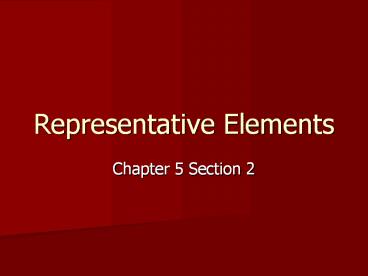Representative Elements - PowerPoint PPT Presentation
1 / 11
Title:
Representative Elements
Description:
Representative Elements Chapter 5 Section 2 Representative Elements Remember that these are the elements in groups 1 and 2 and 13 to 18 Groups are classified by ... – PowerPoint PPT presentation
Number of Views:100
Avg rating:3.0/5.0
Title: Representative Elements
1
Representative Elements
- Chapter 5 Section 2
2
Representative Elements
- Remember that these are the elements in groups 1
and 2 and 13 to 18 - Groups are classified by having similar
properties
3
Group 1 Alkali Metals
- Silvery Solids with low densities and low melting
points - Hydrogen is the only nonmetal in this group
- Tend to increase reactivity down the family
- Lithium (Li) is the least reactive and Francium
(Fr) is the most reactive - Contains Sodium (Na) and Potassium (K) too.
4
Group 2 Alkaline Earth Metals
- Denser and Harder than Alkali Metals
- Have higher melting points
- Are reactive but not as reactive as Alkali metals
- Contains Beryllium (Be), Magnesium (Mg), Calcium
(Ca), Barium (Ba), Radium (Ra)
5
Group 13 Boron Family
- Are all metals except Boron
- Boron is a brittle, black metalloid
- Used to make a variety of products
- Such as Pots and Pans, Aluminum Cans, and
Baseball Bats
6
Group 14 Carbon Family
- A mixture of non-metals, metalloids and metals
- Contains Carbon a non-metal
- Contains Silicon and Germanium
- Tin and Lead are the heaviest metals in this
group - Lead is used to shield humans during X-Rays
7
Group 15 The Nitrogen Group
- The top two elements are nitrogen and phosphorus,
which are used by living things. - Our bodies need nitrogen, but cannot get it
simply from breathing nitrogen from the
atmosphere, bacteria in soil must first convert
the nitrogen into a form we can use (The nitrogen
cycle)
8
Group 16 The Oxygen Family
- The oxygen group contains oxygen and sulfur which
are essential for life and used to manufacture
many products. - Sulfur is a solid, yellow nonmetal. Sulfur is
used to manufacture sulfuric acid, which is used
in fertilizers, detergents, synthetic fiber, and
rubber.
9
Group 17 The Halogen Group
- All of the elements except Astatine are
nonmetals. - The word Halogen means salt former for example
Table salt chemical make up is NaCl, you may
have already noticed that chlorine is a halogen.
All halogens form similar salts - Fluorine is most reactive, it combines with other
elements easily. Chlorine is less reactive than
fluorine but more reactive than bromine.
10
Group 18 The Noble Gases
- They rarely combine with other elements, they are
chemically inactive - Helium is less dense than air so it is used in
balloons. Hydrogen is also less dense, however
Helium will not burn. - Noble gases glow different colors when
electricity is passed through them. Neon lights
are not necessarily just neonunless of coarse
they are reddish orange colored words. - Helium, Argon, and Radon are all elements in this
group - Why would you not expect to combine magnesium and
argon to produce a useful substance?
11
An After thought.
- What are the characteristics of two
representative element groups? How are elements
in these groups used.































